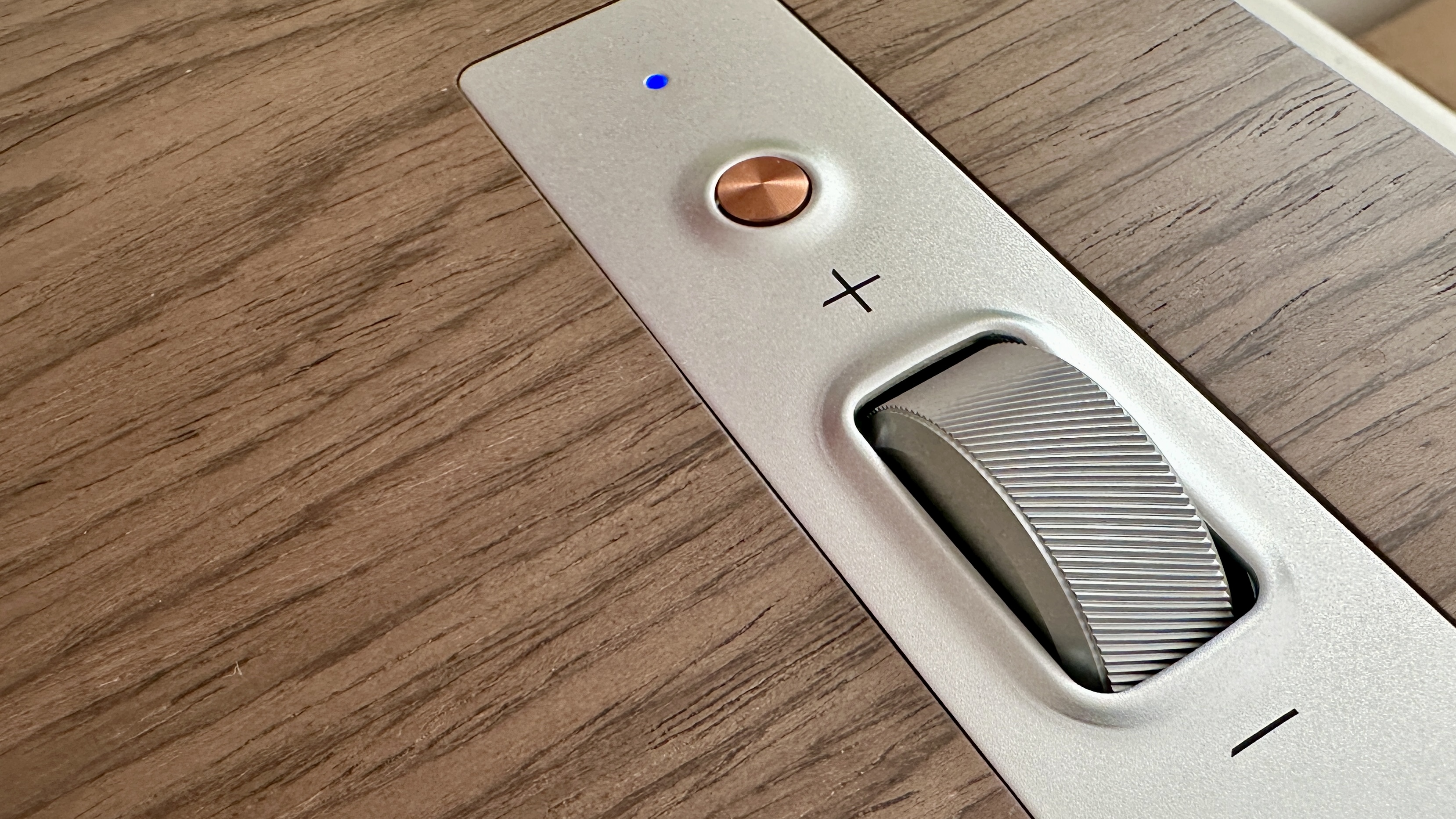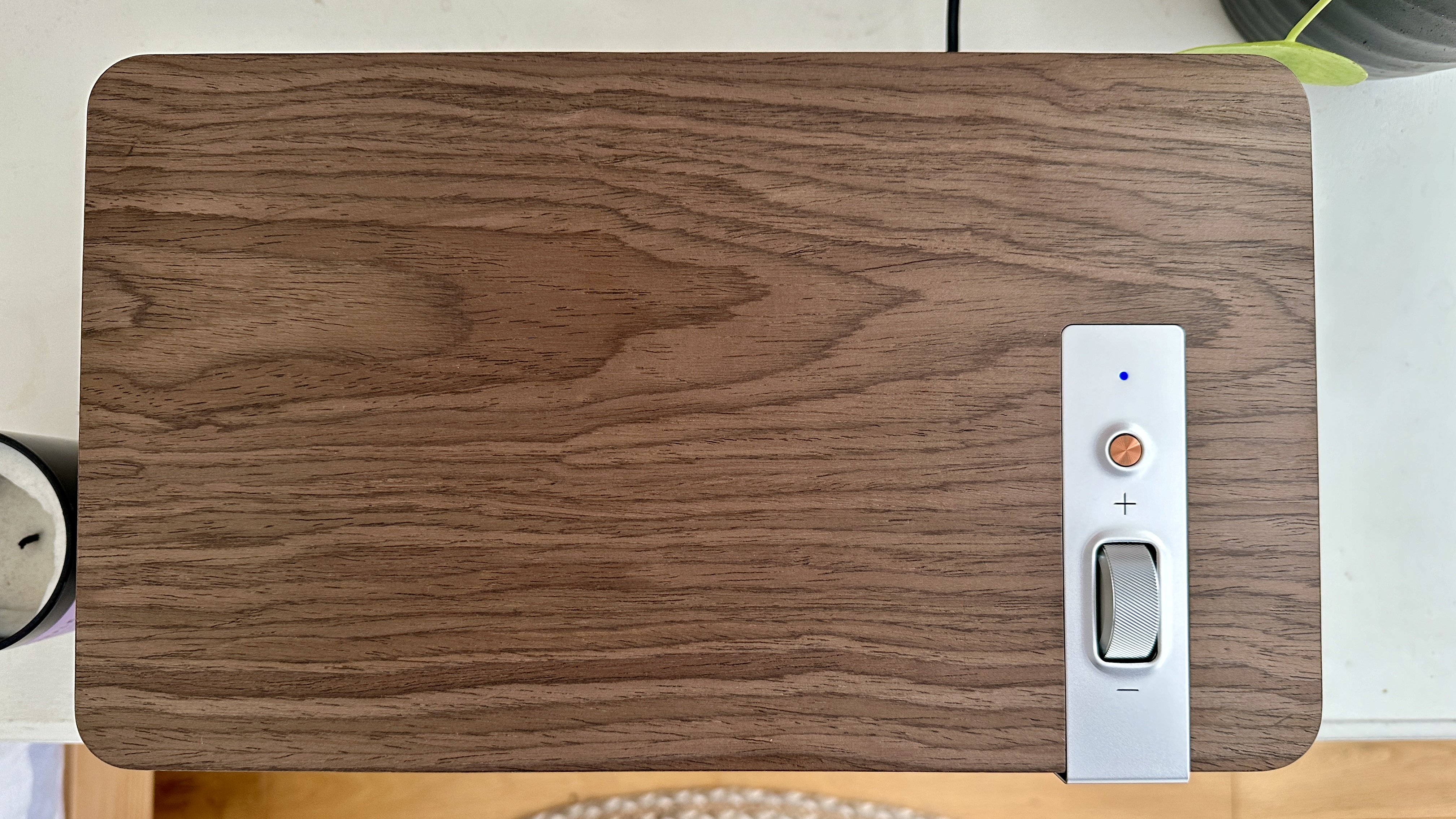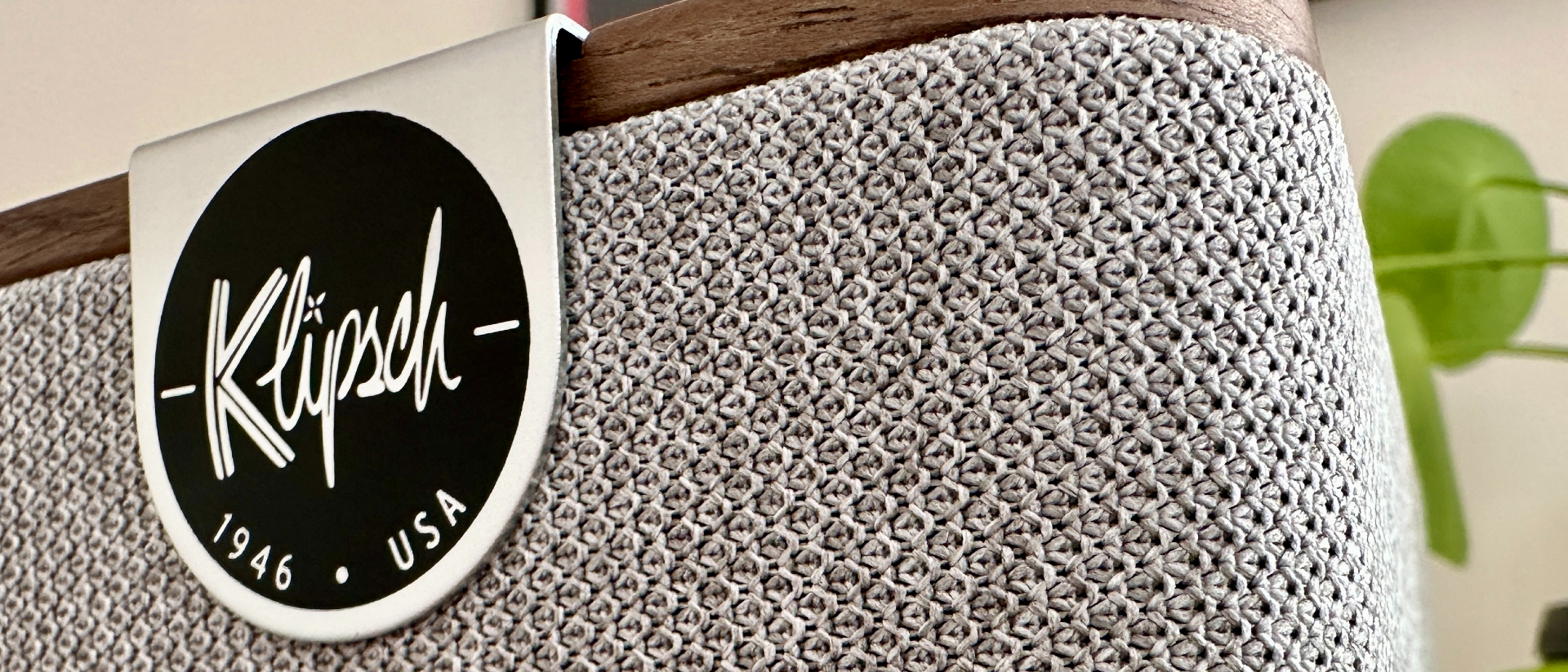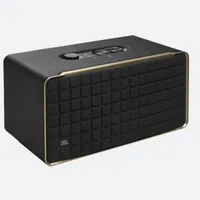TechRadar Verdict
An unlikely amount of functionality from a small, nicely made and thoroughly unassuming box – and quite an unlikely amount of volume, too.
Pros
- +
Assertive, direct and quite detailed sound
- +
Impressive specification at the money
- +
Good standard of build and finish
Cons
- -
Can sound a little bass-happy
- -
Phono stage isn’t the greatest
- -
Doesn’t really fancy being used for ‘background music’
Why you can trust TechRadar
Klipsch The Three Plus: One-minute review
The Klipsch The Three Plus is a slightly awkwardly named wireless speaker with ambition. Despite being the rough size and price of some of the best wireless speakers and looking quite like a wireless speaker too, The Three Plus is, in fact, an all-in-one audio system. An all-in-one system with quite impressive functionality and specification, what’s more.
A selection of wired and wireless connection options means the Klipsch can support quite an array of sources, up to and including a turntable. It’s able to deal with fairly hi-res content without alarms (as long as it’s via an appropriate source). It’s a good-looking, well-made and quite tactile device, and it’s happy to sit more-or-less anywhere that it’s not too boxed in. It’s even got a pretty decent control app.
And in almost every circumstance, it’s an enjoyably upfront and lively listen. Detail levels are fairly high, determination to attack a tune from the bottom up is obvious – but the Klipsch is not blunt or lacking in finesse. Heard through any of its inputs other than the phono stage, it confidently combines attack with dexterity. The phono stage itself, though, is not the most accomplished when it comes to drive or detail retrieval – which means it’s a ‘nice to have’ rather than your go-to input. Anyone after a single-box system to accompany their turntable might have to save up for just a little longer…

Klipsch The Three Plus: Price and release date
- $399 / £379 / AU$529
- Announced September 25, 2023
The Klipsch The Three Plus is on sale now, and in the United Kingdom it’s priced at £379. In the United States it sells for $399, while in Australia the going rate is AU$529. They were first announced on September 25, 2023.
On one hand, in terms of form and function there’s a lot of stuff here for that money here. On the other hand, the Klipsch is attempting to muscle in on territory already hotly contested by brands as credible as Denon, Panasonic and Ruark (to name just three). There’s only one way to find out if The Three Plus makes any sense or not…

Klipsch The Three Plus review: Features
- 120 watts of power
- 2 x 57mm full-range drivers, 1 x 133mm subwoofer, 2 x 133mm passive radiators
- Bluetooth 5.3 with SBC and AAC codec compatibility
On the outside, The Three Plus might seem to be featureless at first glance. The extraordinarily brief control interface on its top surface, which consists of an ‘input selection’ button and little coloured confirmatory LED light plus a nicely tactile volume control wheel, is pretty much your lot — until you look at the back of the box.
Here’s where your physical inputs live. There’s a digital optical input (good for resolutions of up to 24bit/96kHz), a stereo RCA input that’s switchable between line-level and phono level (so the Klipsch is ready to deal with a turntable if you so desire) and a USB-C input that lets smartphones, thumb-drives, PMPs and what-have-you join your system. The socket can be used for reverse charging, and Klipsch specifically suggests it’s capable of powering a WiiM Mini in order to facilitate network streaming too.
Sign up for breaking news, reviews, opinion, top tech deals, and more.
Wireless connectivity, meanwhile, is handled by Bluetooth in 5.3 guise – it’s compatible with SBC and AAC codecs. And the Bluetooth chipset Klipsch has deployed means The Three Plus features ‘Broadcast’ mode – which means the speaker can transmit (as well as receive) Bluetooth information. Transmissions are limited to mono, true, but as many as 10 ‘Broadcast’-enabled speakers can receive and play the signal; the scope for a simple, and extensive, multi-speaker system is obvious. Bear in mind the speaker(s) receiving the signal cannot broadcast it any further, so the range of your system will depend entirely on the primary speaker.
Once your audio information is on board, the digital stuff is pored over by a digital-to-analogue converter that can definitely deal with 24bit/96kHz content – whether or not it needs to downscale this resolution of content is a question Klipsch seems unwilling to answer. The analogue stuff, of course, needs no such attention. Once it’s in the analogue domain, it’s amplified by an all-in total of 120 watts of Class D power before delivery to what Klipsch describes as a 2.1-channel speaker driver array. This consists of a couple of 57mm full-range drivers, bolstered by a 133mm subwoofer that’s supported by a pair of 133mm passive radiators.
Features score: 5/5

Klipsch The Three Plus review: Sound quality
- Assertive, upfront and enjoyable sound
- Maintains its sonic characteristics in most circumstances
- Considers ‘loud’ to be a total virtue
Quite a lot of this review is spent discussing how usefully compact and elegant a device the Klipsch The Three Plus is. But now the talk turns to sound quality – and it’s safe to say there’s nothing compact or especially elegant about the way it sounds. This is a big, bold-sounding device, and while it’s not lacking the poise that might make the description ‘inelegant’ seem appropriate, I get the strong impression that decorum is not uppermost in its mind.
With one notable exception, The Three Plus maintains its attitude across any of its inputs. No matter if you’re streaming a FLAC of John Cale’s Fear is a Man’s Best Friend via Tidal, listening to a 24bit/96kHz file of Weyes Blood’s And in the Darkness, Hearts Aglow via the USB-C input or a CD of Double Drums by Peace Orchestra, the Klipsch is consistent. It came to get down, and it wants to take you with it.
The easiest way to create an impression of sonic ‘excitement’ is via the lower frequencies, of course, and the Klipsch is far from shy here. Bass presence is considerable – but it’s properly controlled and carries a lot of information regarding the details of tone and texture, so The Three Plus stops short of being a blunt instrument. If it’s frankly unlikely punch you want from your unassuming little tabletop device, though, you came to the right place. The Klipsch absolutely motors through low-frequency stuff, keeping momentum levels high and rhythms on the front foot.
The midrange just about manages to keep its head above water, though, and here just as elsewhere The Three Plus extracts a very worthwhile amount of detail. It’s able to grant vocalists the emotional weight and character they require, and it’s actually quite communicative. The presentation is spacious enough to allow the midrange to operate without too much hassle from the bottom end and, while there’s a fairly obvious point-source of sound, the Klipsch never sounds crowded.
Integration through the frequency range is good, and at the top end there’s just about enough bite and shine to balance out the enthusiasm of the bottom end. Tonality is on the warm side of neutral, but not fatally so – and despite the number of drivers and radiators at work here, there’s very agreeable togetherness and singularity about the way The Three Plus presents even quite complex recordings.
The Klipsch is one of those devices that sounds quite loud even when it’s playing quite quietly – its upfront attitude and generally assertive nature are always apparent. But there’s still a fair amount of dynamic headroom available, even if it doesn’t so much go from ‘quiet’ to ‘loud’ but rather from ‘loud’ to ‘louder still’. Even at quite oppressive volume, though, it’s quite composed and doesn’t sound stressed.
The one outlier here is the phono stage. A vinyl alternative of Fear is a Man’s Best Friend lacks a fair bit of the streamed version’s drive and attack – it’s strangely matter-of-fact and lacking both dynamism and insight by comparison. It’s by no means a disaster, the phono stage here. But it doesn’t take all that much of a listen to establish that it’s the input through which The Three Plus sounds least confident and least engaging.
Sound quality score: 4.5/5

Klipsch The Three Plus review: Design
- 178 x 355 x 213mm (HxWxD)
- Walnut or matte black real wood veneer finishes
- 4.8kg
Obviously you’ll make your own mind up about the way The Three Plus looks – but for my money, the combination of a surface that’s covered in a real wood veneer (matte black as well as the walnut of my review sample is available), acoustic cloth tightly wrapped around all four sides, and a little metal strip housing the product’s few physical controls is very nice indeed. The Klipsch, I reckon, looks and feels like a premium item.
At 178 x 355 x 213mm (HxWxD) it’s nicely proportioned, and can be as discreet just as readily as it can be a feature of your decor. Despite the way its drivers and passive radiators are arranged, it’s relaxed about positioning (up to a point – it won’t thank you for being slotted into a space where it’s boxed in on all sides). And the standard of build and finish is certainly up to the sort of level the asking price demands.
Obviously, if you want to exploit its wider connectivity rather than just use it as a Bluetooth speaker, you’ll need to give it a bit of room – all its physical connections are at the rear, after all. Other than these practical considerations, though, the design of the Klipsch is as accommodating and as gratifying as can be.
Design score: 5/5

Klipsch The Three Plus: Usability and setup
- Klipsch ‘Connect’ control app
- A (very) few physical controls
- Self-contained simplicity
It’s difficult to know how the Klipsch The Three Plus could be any friendlier or more straightforward. As long as you take a moment’s care when positioning it (make sure surfaces to the left and right aren’t too close), it’s an absolute piece of cake to live with.
You can control volume using the wheel on the top of the cabinet, and you can cycle through your input options here too. Otherwise, it’s all about the Klipsch ‘Connect’ control app that’s free for iOS and Android. The app is clean and logical, reasonably responsive and useful – here’s where you can check for updates, control playback, select input, fiddle with a three-band EQ (and its five presets) and deploy ‘night mode’ (in order to squash dynamic range and subdue low-frequency response).
Usability and setup score: 5/5
Klipsch The Three Plus: Value
Obviously there are the few little issues with ultimate sound quality, but taken on the whole it’s difficult to argue with the value that’s on offer here. Consider the quality of build and finish of The Three Plus, its decorative nature, its extended functionality and its generally very agreeable sound – and then consider how much Klipsch is asking.
Value score: 4.5/5
Klipsch The Three Plus review: Should you buy it?
Buy it if...
You want functionality and flexibility from a compact device
There’s no arguing with the specification/price ratio here, nor with the handy size of the thing either.
You like nice things
It’s good-looking in a purposeful sort of way, the Klipsch, and feels as good as it looks.
You might treat yourself to another ‘Broadcast’ speaker at some point
It’s not the answer to your ‘multi-room on the cheap’ prayers, but ‘Broadcast’ is nevertheless a worthwhile feature.
Don't buy it if...
You’re expecting out-of-the-box network capability
Wireless stuff is strictly via Bluetooth here – unless you invest in an off-board streamer.
You’ve got your hopes up as far as turntable sound is concerned
Compared to the sound from its other inputs, the Klipsch makes vinyl sound flat and undemonstrative.
You like to listen at ‘background’ levels
Somehow The Three Plus manages to sound like it’s playing loud even when it’s playing quietly.
Klipsch The Three Plus review: Also consider
JBL Authentics 500
The JBL Authentics 500 isn’t a direct like-for-like alternative for the Klipsch The Three Plus, but it’s a product with a similar attitude. It doesn’t have a phono stage, but it has wi-fi connectivity. It doesn’t have an optical input, but it’s configured to serve up Dolby Atmos spatial audio. And they both have the ability (and absolute willingness) to play very loud indeed if that’s the sort of thing you fancy…
Read more in our JBL Authentics 500 review
Klipsch The Three Plus review: How I tested
- Tested every available input
- Played all sorts of music and different file types
- Tried it out in a range of locations
I tested the Klipsch The Three Plus over the course of a working week, and listened to it pretty much all day every day. I positioned it on an equipment rack, on a bookshelf and on a chest of drawers. I used each of its physical inputs at some point (to listen to a turntable, a CD player and a portable music player) as well as connecting a smartphone and the same portable music player via Bluetooth. I played all sorts of music, and in terms of digital audio I listened to many different types and sizes of file. I listened to it at big volumes, and as quietly as it is prepared to go (which is not, as I mentioned, perhaps as quiet as it might be).
- First reviewed May 2024
- Read more about how we test

Simon Lucas is a senior editorial professional with deep experience of print/digital publishing and the consumer electronics landscape. Based in Brighton, Simon worked at TechRadar's sister site What HiFi? for a number of years, as both a features editor and a digital editor, before embarking on a career in freelance consultancy, content creation, and journalism for some of the biggest brands and publications in the world.
With enormous expertise in all things home entertainment, Simon reviews everything from turntables to soundbars for TechRadar, and also likes to dip his toes into longform features and buying guides. His bylines include GQ, The Guardian, Hi-Fi+, Metro, The Observer, Pocket Lint, Shortlist, Stuff T3, Tom's Guide, Trusted Reviews, and more.

